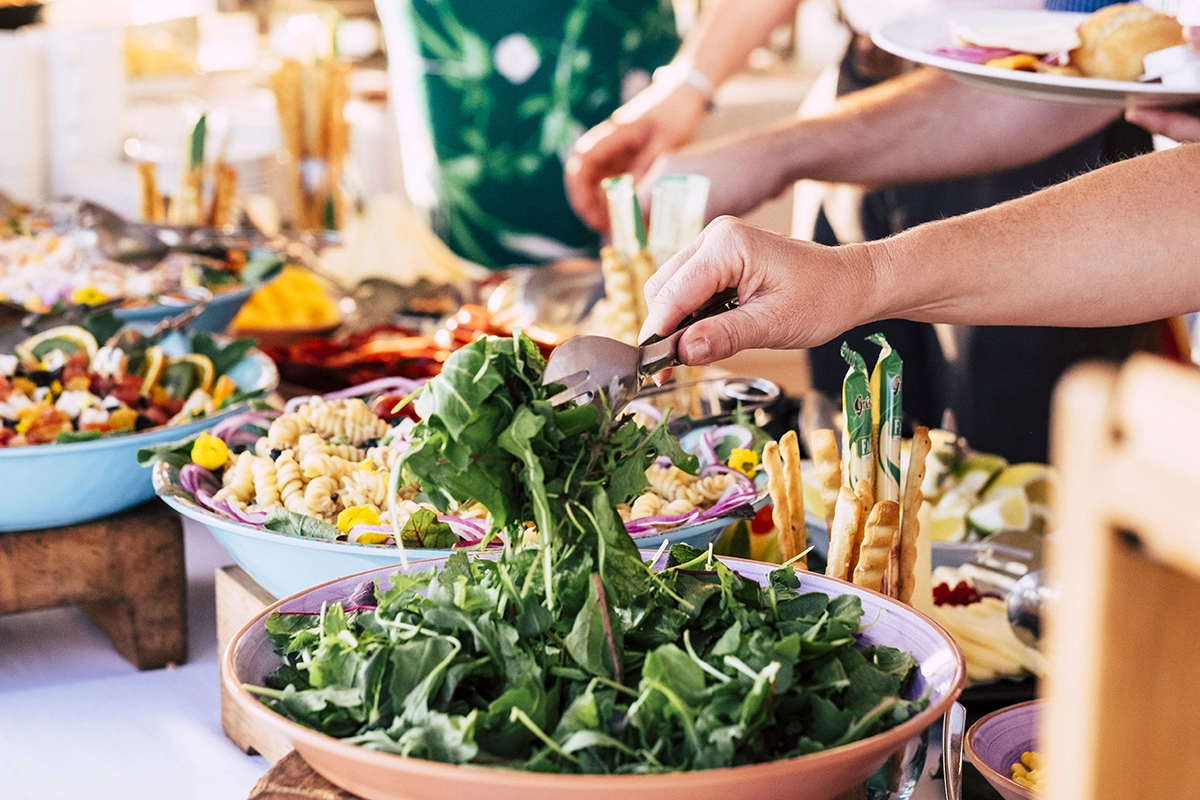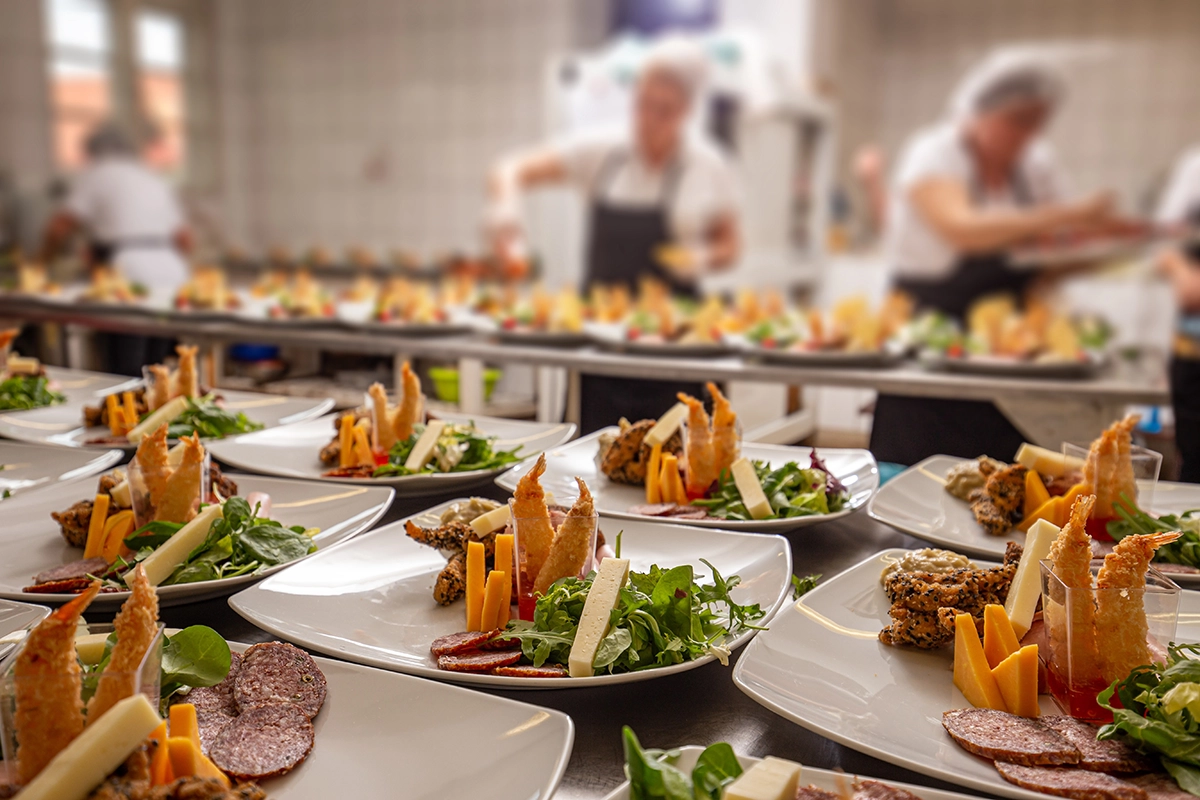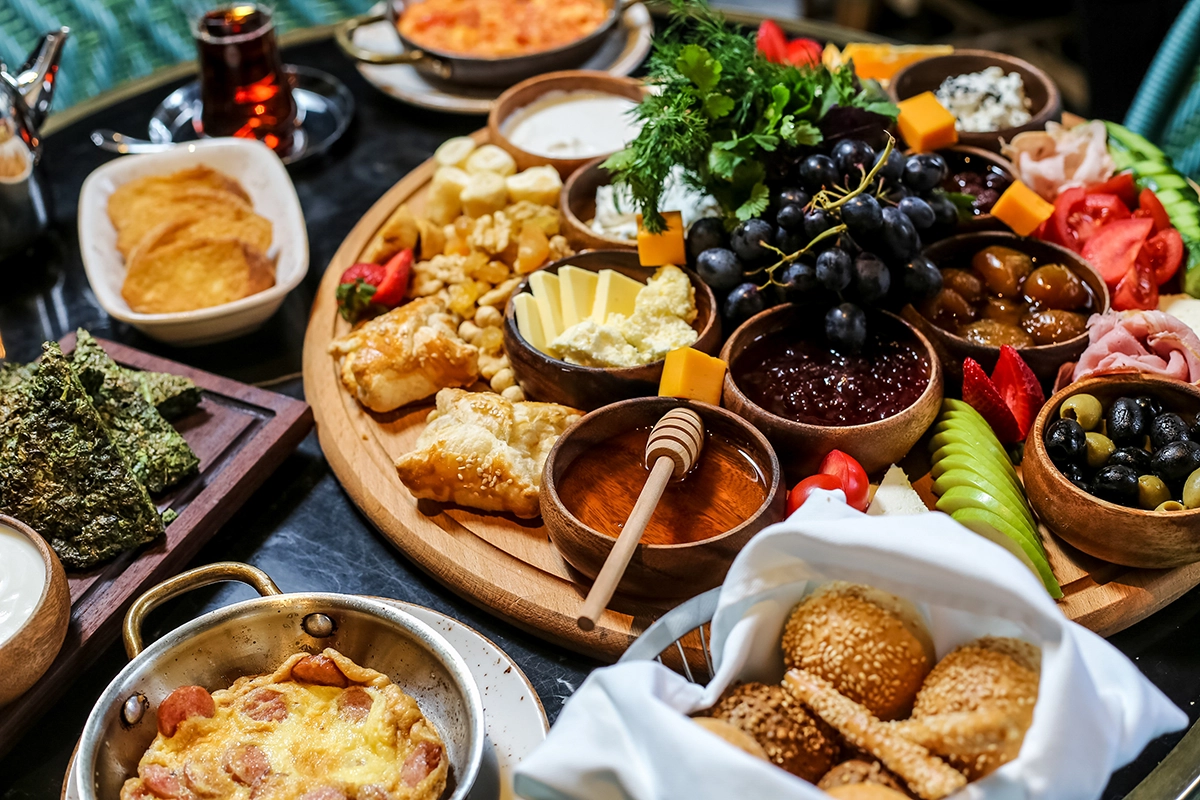Table Of Contents
Corporate Catering Trends 2026: What Scottsdale Companies Are Prioritizing Now
Why Corporate Catering Has Become a Strategic Business Priority
Corporate catering has evolved from a workplace perk into a strategic lever for culture, performance, and brand perception.
As companies refine their return-to-office strategies, food has emerged as one of the most effective tools for boosting in-person participation and creating workplaces employees actually want to be part of.
High-end catering delivers something most initiatives cannot: shared moments that reset atmosphere, reinforce belonging, and make the workday feel worthwhile.
Organizations now use culinary programming to strengthen loyalty and retention, support performance and wellness during long workdays, impress clients and leadership during high-stakes events, and communicate brand values without saying a word.
Premium catering has become an investment because it elevates business results. Teams collaborate more effectively. Guests are more receptive. Executives notice excellence.
The 2026 corporate catering landscape demands dependability with logistics-level precision, fully inclusive menus that feel luxurious rather than restrictive, zero-waste sustainability, on-brand presentation, and elevated culinary experiences that rival high-end restaurants.
From hyper-local Arizona sourcing and plant-forward fine dining to interactive chef stations and curated tasting menus—corporate catering is transforming into a new category of hospitality.
National Corporate Catering Trends Shaping 2026
Dependability as a Non-Negotiable Standard
In 2026, reliability isn't just important—it's baseline. Corporate planners expect their caterer to perform with the precision of a logistics company.
Timely arrivals that align with meeting schedules, pinpoint accuracy in orders, and temperature-controlled delivery methods are now standard requirements.
Caterers who provide branded delivery tracking and service-level agreements (SLAs) are quickly rising in preference.

Catering as Culture and HR Strategy
Weekly food programming—like "Mediterranean Mondays" or "Wellness Wednesdays"—is gaining traction as part of corporate culture.
Companies weave food into DEI initiatives, social events, and wellness programs because it creates memorable shared experiences.
Leadership teams increasingly use food strategically to boost morale after stressful milestones or celebrate key wins.
Technology-Enhanced Dining Experiences
Corporate clients value convenience and personalization powered by technology.
Predictive ordering based on past events, mobile allergen menus, QR code ingredient transparency, and AI-assisted meal customization are trending.
Accessibility features—such as screen-reader–friendly menus and visual ordering tools—have become standard expectations among large employers.
Global, Wellness-Driven Menus
Corporate meals are more adventurous than ever.
Companies are embracing elevated global street foods, superfood-based recipes, mushroom proteins, ancient grains, and menus tailored to support cognitive performance and anti-inflammatory wellness.
This evolution reflects a deeper understanding that what teams eat affects how they think and feel at work.
Interactive Service Styles That Encourage Networking
Static buffets are giving way to social dining formats such as live chef stations, grazing tables, and themed installations.
Culinary experiences now blend food and atmosphere—complete with curated beverage pairings—to help corporate events feel memorable rather than merely functional.
Sustainability as a Core Value in Luxury Corporate Catering
For modern corporate clients, sustainability signals environmental responsibility and brand sophistication.
Top-tier caterers integrate eco-conscious practices at every level through water-efficient prep, energy-smart kitchens, compostable or reusable serviceware, local sourcing to cut transport emissions, and partnerships with regenerative farms and ethical suppliers.
Menus reduce waste through seasonal, locally sourced ingredients and creative luxury alternatives that replace high-waste items.
Surplus-food collaborations support communities instead of discarding leftovers. Printed materials have been replaced by QR codes, LED boards, and mobile-access ingredient lists—maintaining polished presentation with zero paper waste.
Clients now vet catering partners on eco-standards. Sustainability is more than a trend—it's a benchmark of sophistication, responsibility, and forward-thinking corporate values.
Plant-Forward, Inclusive and Dietary-Accommodating Menus
The Rise of Plant-Forward Fine Dining
Plant-centered menus no longer signal compromise—they signal creativity and luxury.
Global fusion dishes like Thai basil tofu stir-fries or Moroccan chickpea tagines have become staples of high-end events because they're flavorful, vibrant, and inclusive across dietary lifestyles.
Accommodating Without Segregating
Corporate groups expect menus that serve vegans, vegetarians, keto followers, and gluten-free diners without creating a hierarchy of main options versus substitutes.
From almond-flour breads to jackfruit carnitas, premium allergen-friendly ingredients allow all guests to enjoy elevated cuisine without feeling sidelined.
Luxury setups increasingly include dedicated allergen-separate stations, detailed ingredient labeling, and staff trained to manage allergies confidently and discreetly.
Transparency around nutritional macros and caloric visibility is also in demand for wellness-focused teams.

Healthy Meets Indulgent
The new goal isn't simply healthy food—it's healthy food that feels luxurious.
Expect gourmet salads layered with textures and flavors, antioxidant-rich bowls plated like fine dining, and entrées built on clean eating principles without sacrificing richness.
This "clean indulgence" movement lets guests feel pampered and energized—not weighed down—during long meetings and corporate programming.
Hyper-Local and Regionally Inspired Culinary Design
Arizona on the Plate—Authenticity as Luxury
The next evolution in high-end corporate catering isn't about imported exclusivity—it's about telling a story through food.
Guests today are drawn to menus that reflect their location, offering a sense of place and purpose.
In Arizona, that means moving past generic Southwestern motifs to highlight ingredients that genuinely define the region's culinary landscape.
As Chef Kevin Wootton of Tableside Gourmet explains:
"We focus on ingredients that truly represent Arizona: Arizona-grown citrus, mesquite honey, native herbs, grass-fed beef, heritage grains, and heirloom vegetables sourced directly from small farms across the Sonoran region."
By emphasizing provenance and regional excellence, corporate menus become more than meals—they become memorable, place-based experiences that guests associate with both luxury and authenticity.
Micro-Producers as Culinary Co-Stars
Partnerships with artisanal cheese makers, boutique olive groves, desert botanical growers, and small-batch chocolatiers elevate corporate events from simply local to curated and exclusive.
Featuring a micro-producer by name on the menu—along with QR links to their story—adds prestige, promotes sustainability, and creates instant conversation among attendees.
The Southwest Meets Global Gastronomy
Menus are leaning into Southwestern flavor foundations infused with global luxury influences—think charred Hatch chile miso butter on wagyu, smoked-citrus ponzu crudo, or mole-spiced truffle risotto.
The effect is simultaneously rooted and forward-thinking. Seasonal cycles are now built into menu rotation strategy, ensuring fresh harvest timing and ever-evolving culinary surprise.
Honoring Indigenous Food Traditions
The most memorable menus integrate Indigenous culinary elements responsibly and collaboratively—with acknowledgment, cultural accuracy, and reciprocal partnerships rather than appropriation.
It's a luxury that feels meaningful, ethical, and place-aware.
Interactive Food Experiences and Modern Service Styles
Culinary Theater—Food That Performs
Corporate audiences expect more than nourishment—they expect an experience. Flame-searing wagyu, tableside torching of elote brûlée, live risotto wheel carving, mezcal-smoked cocktails, or fresh pasta hand-rolled in front of guests turns dining into an immersive spectacle.
These high-engagement moments create emotional memory, not just taste.

Bars, Stations and Mobile Culinary Studios
Build-your-own experiences are evolving into chef-supervised experiential bars, including taco bars with heirloom nixtamal tortillas, sushi burrito bars, poke stands, dim sum carts, risotto wheels, and arepa stations.
Every stop becomes a networking micro-hub, especially at conferences and corporate galas.
Beverage experiences add new layers of personalization: mocktail gardens, nitro cold brew stations, tea sommeliers, infusion bars, and bourbon libraries.
When drinks become bespoke, the entire event feels bespoke.
Designed for Hybrid Event Movement
Modern corporate venues require motion-friendly layouts so attendees can eat without interrupting conversations, presentations, or brainstorming sessions.
Caterers are incorporating ergonomic dishware, stand-and-mingle grazing, and strategically positioned service flows to support connection rather than interrupt it.
Made for the Camera
Instagram-forward plating is intentional, not vain.
Corporate attendees regularly share event moments, and visually dramatic food multiplies reach before the keynote even begins.
Lighting-friendly surfaces, interactive garnishes, and vertical height presentations encourage organic social amplification.
The Rise of Quality-Focused, Curated Menus
Less Volume, More Vision
The buffet-of-everything era is fading. High-end corporate catering is embracing curated menus centered around chef signatures instead of sprawling catalogs.
Every dish on the menu has a reason to exist—seasonal relevance, ingredient story, cultural tie-in, or event symbolism.
A Menu That Aligns With the Mission
Corporate events increasingly use food to support messaging.
Themes such as innovation, sustainability, unity, diversity, or leadership are reflected through menu metaphors, ingredient origins, and plating style. Food becomes an extension of brand identity.
For board dinners, investor events, and executive retreats, catering now mirrors Michelin-style hospitality—multi-course progressive tasting menus with tableside narration, wine pairing strategies, and intermezzo breaks that support pacing and conversation.
Built for Different Moments of the Event
One of the most practical evolutions is modular menu design—light, energizing fare during working sessions; fueling stations for long conference days; celebratory menus for award nights; and late-night comfort menus that sustain after-party networking.
When honorees or keynote speakers come from diverse cultural backgrounds, menus may include heritage dishes reinterpreted with fine-dining technique.
This adds depth and emotional warmth—an elevated, sophisticated way to celebrate people, history, and identity.
Personalization and Ultra-Luxe Touches in Corporate Events
Luxury Is Personal
Corporate events are moving into an era of quiet luxury—not showy excess but meticulous, deeply personal touches.
Examples include custom-engraved menu cards, edible corporate logos, or personalized welcome plates for VIPs and keynote speakers that subtly acknowledge their importance.
Rather than heavy signage, caterers are integrating branding through corporate-color garnishes, signature cocktail hues, tabletop florals matching corporate palettes, and branded flavors inspired by company values.
It's immersive without being promotional.
Multi-Sensory Immersion
Ultra-luxury corporate catering pushes beyond taste by incorporating scent pairing, curated soundscapes, and lighting that shifts with courses.
Events feel cinematic rather than transactional.
For high-stakes corporate events—investor nights, product launches, C-suite gatherings—chef-hosted tableside storytelling or plated presentations increases engagement dramatically.
Diners feel like insiders, not attendees.
Tailored Experiences for Every Guest
From vegan dignitaries to gluten-free athletes to executives on performance nutrition plans, personalization today means accommodating not just restrictions—but preferences, identity, and lifestyle philosophy. It says: you're not just invited; you're seen.
The new definition of luxury is less about spectacle and more about thoughtfulness, detail, and connection.
Step-by-Step Roadmap to Booking a Luxury Caterer in Scottsdale
Booking a high-end corporate caterer isn't just about choosing a menu—it's about selecting a strategic partner that elevates the event's purpose, brand, and guest experience.
Step 1—Define Event Requirements with Precision
Start by clarifying what the catering should achieve. Is the goal networking? Energizing teams between presentations? Impressing executives or clients? Supporting an awards gala?
Evaluate venue logistics—indoor versus outdoor, rooftop versus corporate office, ballroom versus conference floor.
The earlier you share constraints, the more creatively a caterer can design solutions. Determine branding and experiential goals in advance so culinary storytelling aligns with the event theme.
Step 2—Research Local Luxury Caterers
In Scottsdale's high-end market, portfolios say more than advertisements. Review case studies and past corporate events, sample menus and seasonal rotations, and photo galleries and video recaps.
Look beyond food—confirm corporate-scale staffing capabilities, scheduling flexibility, and familiarity with large venues, resorts, and conference production teams.
Step 3—Request Quotes and Strategy Calls
Pricing should be transparent. Compare rentals, service charges, staffing surcharges, holiday fees, décor add-ons, and bar packages.
Ask whether the team can scale upward quickly if attendance increases. A luxury caterer should solve stress—not create it.
Step 4—Attend a Private Tasting
This is more than sampling flavor. Evaluate timing consistency between courses, staff hospitality and professionalism, and plate presentation speed and organization.
Observe whether the experience feels polished, confident, and well-coordinated—that's how service will feel at your event.
Step 5—Finalize the Contract with Total Clarity
Confirm every deliverable in writing—linens, ice, glassware, décor, dietary accommodations, arrival times, cleanup responsibilities, backup plans for weather, and transportation contingencies.
A luxury caterer never leaves ambiguity.
Step 6—Maintain Strategic Communication Until Event Day
Share run-of-show updates, floor plans, and VIP needs no later than 10 days prior. Provide point-of-contact details for event day to streamline communication.
A well-aligned caterer integrates seamlessly with production, entertainment, and venue teams.
Final Thoughts—Elevating Corporate Catering in 2026
Corporate catering in 2026 is no longer about simply serving food—it's about creating purposeful experiences that align with culture, brand, and guest expectations.
From hyper-local, regionally inspired ingredients to plant-forward, inclusive menus; from immersive food stations to ultra-luxury personalization; and from sustainability as a core value to flawless operational execution—every detail shapes how an event is remembered.
The caterers who truly deliver combine consistency over flash, a partnership mindset that anticipates needs and solves problems proactively, creativity paired with operational mastery, a focus on making the planner shine in front of executives and clients, and forward-thinking innovation in sustainability, wellness-driven menus, and evolving corporate food culture trends.
If your organization is planning corporate events in Scottsdale in 2026 and you want a catering partner who turns every meal into an unforgettable experience, Tableside Gourmet is ready to elevate your next event.
Reach out today to discuss how our luxury, full-service catering can support your goals, impress your team and clients, and set a new standard for corporate hospitality.
FAQ: Corporate Catering Trends 2026
1. Why is sustainability now a non-negotiable standard in luxury corporate catering?
Sustainability signals both environmental responsibility and brand sophistication. In 2026, corporate planners expect caterers to minimize waste, source locally, use eco-friendly packaging, and partner with ethical suppliers. It’s no longer a bonus—it’s part of the luxury experience.
2. How can corporate catering support employee wellness and engagement?
Plant-forward, nutrient-rich menus, clean-indulgence dishes, and allergen-conscious options help teams stay energized during long workdays. Weekly culinary programs—like “Wellness Wednesdays” or themed global menus—reinforce culture, encourage collaboration, and make the office a place employees want to be.
3. What role does technology play in modern corporate catering?
From predictive ordering to QR-code menus, allergen transparency, and AI-assisted customization, technology enhances convenience, personalization, and accessibility. It also allows real-time updates and data-driven insights, ensuring every guest’s experience is seamless and precise.
4. How can hyper-local and regionally inspired menus elevate corporate events?
Menus that highlight local ingredients—like Arizona-grown citrus, mesquite honey, and heritage grains—tell a story of place and authenticity. Incorporating artisanal micro-producers and seasonal cycles adds prestige, creates conversation, and transforms meals into memorable, branded experiences.
5. What should planners look for in a luxury corporate caterer for 2026?
Top-tier caterers combine operational precision with culinary creativity. Look for partners who anticipate needs, execute flawlessly under pressure, integrate sustainability, personalize for dietary preferences, and elevate every detail to align with brand messaging and event objectives.







